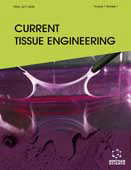Abstract
Fibrillar collagen/bioactive glass-ceramic porous composites for bone tissue engineering are presented here. Bioactive calcium phosphate silicate (CPS) glass-ceramic was synthesized via developed by multi-step sol-gel procedure and adsorbed from acidic suspension onto fibrillar collagen matrix, preliminary prepared by freeze-dry technology. Fibrillar collagen/bioactive glass ceramic porous composites were fabricated at varied ratios of the components (wt. %): 20:80, 50:50 and 80:20.
The fibrillar collagen/bioactive glass-ceramic porous composites were characterized by FTIR, X-Ray diffraction (XRD), SEM, Inductive Coupled Plasma-Optical Emission Spectrometry (ICP-OES), enzymatic biodegradation, in vitro bioactivity (1.5 SBF test) and interactions with osteoblast cells (OC). FTIR, XRD and SEM confirmed the presence of the characteristic for the natural bone carbonate hydroxyapatite (CO3HA, bioapatite) in the studied composites. A possible explanation of its formation was hypothesized. Correlation between the expression profiles of the osteogenic markers and the fibrillar collagen matrix mineralization indicated the appearance of gene expression for OC and BSP II, leading to characteristic for the osteoblastic phenotype changes, and to an onset mineralization process through bone nodule small rounded lump formation on the studied fibrillar Coll/CPS glass-ceramic composites at 39°C.
Keywords: Bone tissue engineering, characterization, fibrillar collagen/bioactive glass ceramic composites, osteoblasts behavior and gene expression, SBF in vitro bioactivity.
 13
13

